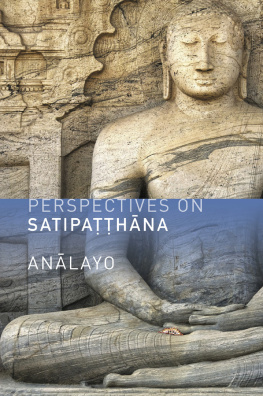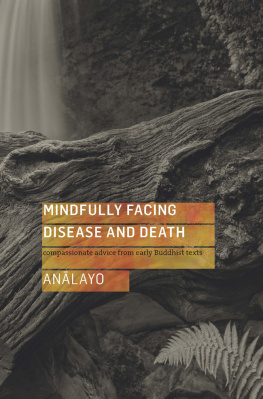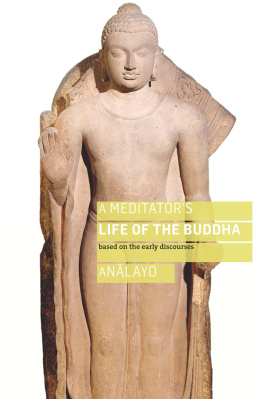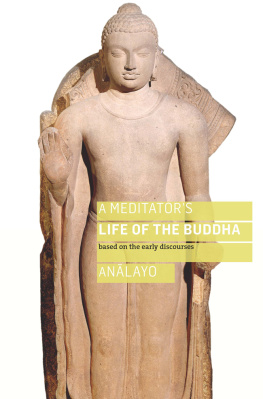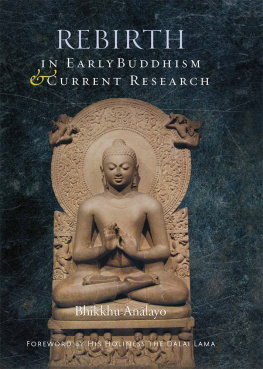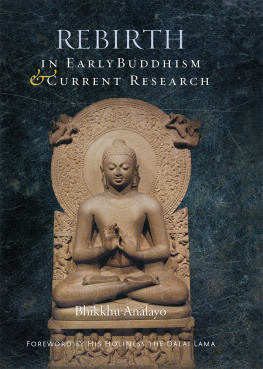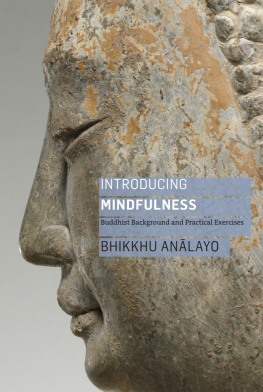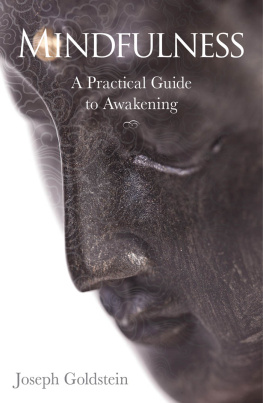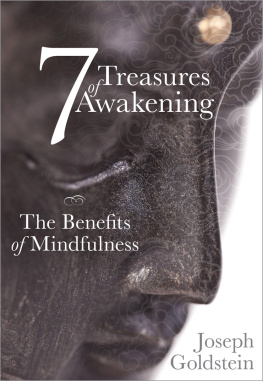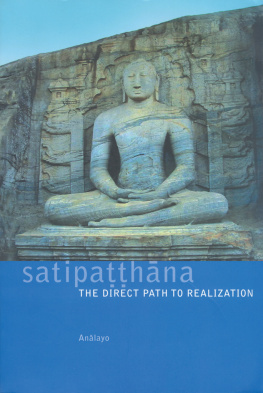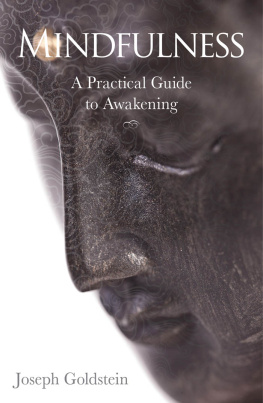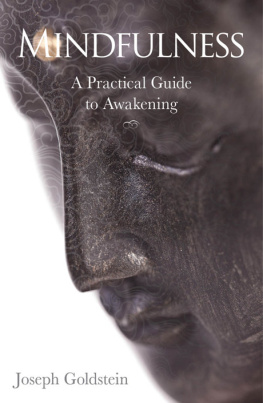In this new book, Anlayo builds on his earlier groundbreaking work, Satipahna: The Direct Path to Realization. Here, he enlarges our perspective on this seminal teaching by exploring the practices of mindfulness as presented in both the Pli and Chinese versions of this important discourse. The brilliance of his scholarly research, combined with the depth of his meditative understanding, provides an invaluable guide to the liberating practices of the Buddhas teaching. This book is not for beginners looking for a general introduction to mindfulness. Rather, it is a work of profound research and investigation, offering a thorough, and often subtle, analysis of how we can understand the causes of suffering and realize the potential for freedom. Joseph Goldstein, author of Mindfulness: A Practical Guide to Awakening, co-founder of the Insight Meditation Society, Barre, Massachusetts, USA
Anlayo shows that the practical instructions on Satipahna from these three traditions are sometimes identical, and sometimes different. The differences are often interesting, adding new perspectives to what we already knew; and affirming, where the traditions speak in one voice, the authenticity of the oral instructions and the likelihood that this was the actual teaching of the historical Buddha. This book will be useful for experienced seekers after truth who want to immerse themselves more deeply, and in more detail, in the core Buddhist practice of Satipahna. Kamalashila, author of BuddhistMeditation: Tranquillity, Imagination and Insight, co-founder of Vajraloka Meditation Centre, Wales, UK
Anlayos work is a treasury of impeccable scholarship and practice, offering a wise, open-minded and deep understanding of the Buddhas original teachings. His approach makes an inspiring contribution to the modern Dharma world. Jack Kornfield, author of The Wise Heart, founding teacher of Spirit Rock Meditation Center, Woodacre, California, USA
Anlayo has offered us a work of great scholarship and wisdom that will be of immense benefit to anyone who wants to seriously study or to establish a practice of mindfulness. Sharon Salzberg, author of Lovingkindness, co-founder of the Insight Meditation Society, Barre, Massachusetts, USA
PERSPECTIVES
ON
SATIPAHNA
Anlayo

Published by
Windhorse Publications
169 Mill Road
Cambridge CB1 3AN
UK
info@windhorsepublications.com
www.windhorsepublications.com
Anlayo, 2013
The right of Anlayo to be identified as the author of this work has been asserted by him in accordance with the Copyright, Designs and Patents Act 1988.
As an act of Dhammadna, Anlayo has waived royalty payments for this book.
The index was not compiled by the author.
Cover design by Dhammarati
Original typesetting by Ben Cracknell Studios
British Library Cataloguing in Publication Data:
A catalogue record for this book is available from the British Library.
Paperback ISBN: 978-1-909314-03-0
ebook ISBN: 978-1-909314-36-8
A Windhorse Publications ebook
Windhorse Publications would be pleased to hear about your reading experiences with this ebook at info@windhorsepublications.com
References to Internet web sites (URLs) were accurate at the time of writing. Neither the author nor Windhorse Publications is responsible for URLs that may have expired or changed since the manuscript was prepared.
LIST OF FIGURES
ABOUT THE AUTHOR
Born in 1962 in Germany, Bhikkhu Anlayo was ordained in 1995 in Sri Lanka, and completed a PhD on the Satipahna-sutta at the University of Peradeniya, Sri Lanka, in 2000 published in 2003 by Windhorse Publications under the title Satipahna: The Direct Path to Realization.
Anlayo is a professor of Buddhist studies at the Sri Lanka International Academy in Pallekele. He also teaches at the Center for Buddhist Studies of the University of Hamburg and researches at the Dharma Drum Buddhist College in Taiwan. His main research area is early Buddhism and in particular the topics of the Chinese gamas, meditation, and women in Buddhism. Besides his academic pursuits, he spends about half of his time in meditation under retreat conditions and regularly teaches meditation courses in Asia and the West.
ACKNOWLEDGEMENTS
I am indebted to Jake Davis, Smaer Dhammadinn, Aldo di Domenico, Sean Fargo, Robert Goodman, Kamalashila, Shi Kongmu, Ken Su, Shi Syinchen, Vishvapani, and Dhatvisvari for having helped me to improve my presentation. Any shortcomings in the following pages are entirely due to my own ignorance.
Contemplate the body by establishing mindfulness, diligently energetic, rightly knowing and rightly mindful, overcoming desires and discontent in the world. In the same way feelings mind dharmas This is called having oneself as an island by relying on oneself, having the Dharma as an island by relying on the Dharma, having no other island and no other reliance.
INTRODUCTION
This book is a follow-up to my study of satipahna as the direct path to realization.
As the present volume is a companion to my earlier publication, in what follows I do not cover comprehensively all relevant topics, primary sources, and secondary literature. Instead, I selectively take up what, in my opinion, is of practical significance and complements my previous book. Thus a basic familiarity with what I covered in my earlier study is needed to contextualize what I discuss in the present monograph.
My study is based on excerpts from the Satipahna-sutta found in the Majjhima-nikya of the Theravda Pli canon and the two main canonical discourse parallels transmitted by other Buddhist schools. These two parallels are preserved in Chinese translation, found in the Madhyama-gama and in the Ekottarika-gama. I provide a continuous translation of these three canonical versions at the end of the book in Besides the Satipahna-sutta and its two discourse parallels, other discourses also give important indications on the practice of mindfulness. I have sought to incorporate a representative selection of this material by including translations of excerpts that are mostly taken from discourses in the Chinese gamas, but at times also from Sanskrit fragments or Tibetan parallels. Most of these have to my knowledge so far not been translated into English. All translations in the following pages are my own.
In translating the parallel versions preserved in Chinese and other languages, I do not intend to imply a judgement of any kind about the relative value of these discourses vis--vis the Pli canon. Instead, I offer these translations merely as an expedient means to enable the reader to gain a first-hand impression of the situation in these parallel versions. The wealth of discourses preserved in the Chinese gamas is largely unknown to the general reader, mostly due to the lack of translations. Hence I attempt to provide translations of at least a selection of relevant passages. In the footnotes to my translations I give references to the standard English translations of the relevant Pli passage in order to facilitate comparison beyond the selected observations that I give regarding variations between the parallels.
In addition to the material found in the discourses, several texts This is also not intended as a judgement on the value of those texts. It only reflects my attempt to explore first and foremost the early discourses as the type of text that in general reflects the earliest stages in the history of Buddhist thought. In this way, I hope to provide a reference point that enables others to delineate in detail the important contributions made by later traditions to

